NASA’s Opportunity Mars rover discovered clay minerals at Cape York ridge along the rim of Endeavour crater – seen in this photo mosaic – which stands as the most favorable location for Martian biology discovered during her entire nearly 10 year long mission to Mars. Opportunity also established a new American driving record for a vehicle on another world on May 15, 2013 (Sol 3309) and made history by driving ahead from this point at Cape York. This navcam photo mosaic shows the view forward to her next destinations of Solander Point and Cape Tribulation along the lengthy rim of huge Endeavour crater spanning 14 miles (22 km) in diameter.
Credit: NASA/JPL/Cornell/Ken Kremer (kenkremer.com)/Marco Di Lorenzo
Updated: Illustrated below with a collection of imagery, mosaics and route maps[/caption]
Now nearly a decade into her planned 3 month only expedition to Mars, NASA’s longest living rover Opportunity, struck gold and has just discovered the strongest evidence to date for an environment favorable to ancient Martian biology – and she has set sail hunting for a motherlode of new clues amongst fabulous looking terrain!!
Barely two weeks ago in mid-May 2013, Opportunity’s analysis of a new rock target named “Esperance” confirmed that it is composed of a “clay that had been intensely altered by relatively neutral pH water – representing the most favorable conditions for biology that Opportunity has yet seen in the rock histories it has encountered,” NASA said in a statement.
The finding of a fractured rock loaded with clay minerals and ravaged by flowing liquid water in which life could have thrived amounts to a scientific home run for the golf cart sized rover!
“Water that moved through fractures during this rock’s history would have provided more favorable conditions for biology than any other wet environment recorded in rocks Opportunity has seen,” said the mission’s principal investigator Prof. Steve Squyres of Cornell University, Ithaca, N.Y.
Opportunity accomplished the ground breaking new discovery by exposing the interior of Esperance with her still functioning Rock Abrasion Tool (RAT) and examining a pristine patch using the microscopic camera and X-Ray spectrometer on the end of her 3 foot long robotic arm.
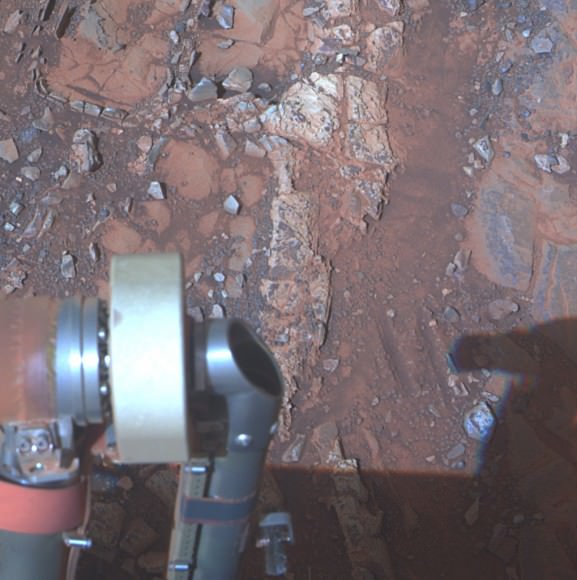
The robot made the discovery at the conclusion of a 20 month long science expedition circling around a low ridge called “Cape York” – which she has just departed on a southerly heading trekking around the eroded rim of the huge crater named “Endeavour.”
“Esperance was so important, we committed several weeks to getting this one measurement of it, even though we knew the clock was ticking.”
Esperance stems from a time when the Red Planet was far warmer and wetter billions of years ago.
“What’s so special about Esperance is that there was enough water not only for reactions that produced clay minerals, but also enough to flush out ions set loose by those reactions, so that Opportunity can clearly see the alteration,” said Scott McLennan of the State University of New York, Stony Brook, a long-term planner for Opportunity’s science team.
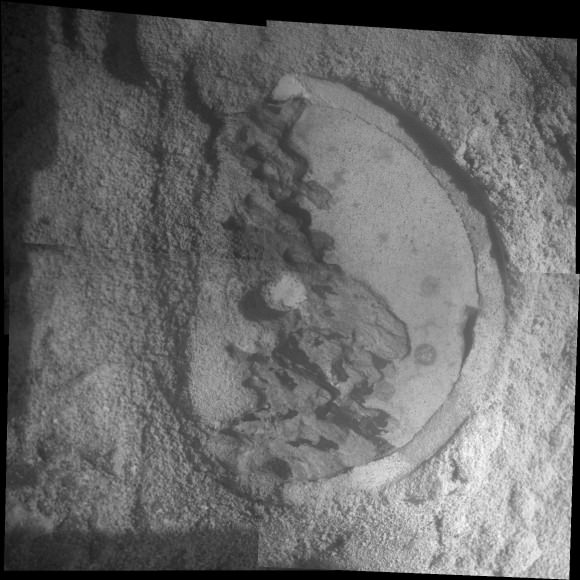
This mosaic of four frames shot by the microscopic imager on the robotic arm of NASA’s Mars Exploration Rover Opportunity shows a rock target called “Esperance” after some of the rock’s surface had been removed by Opportunity’s rock abrasion tool, or RAT. The component images were taken on Sol 3305 on Mars (May 11, 2013). The area shown is about 2.4 inches (6 centimeters) across. Credit: NASA/JPL-Caltech/Cornell/USGS
Esperance is unlike any rock previously investigated by Opportunity; containing far more aluminum and silica which is indicative of clay minerals and lower levels of calcium and iron.
Most, but not all of the rocks inspected to date by Opportunity were formed in an environment of highly acidic water that is extremely harsh to most life forms.
Clay minerals typically form in potentially drinkable, neutral water that is not extremely acidic or basic.
Previously at Cape York, Opportunity had found another outcrop containing a small amount of clay minerals formed by exposure to water called “Whitewater Lake.”
“There appears to have been extensive, but weak, alteration of Whitewater Lake, but intense alteration of Esperance along fractures that provided conduits for fluid flow,” said Squyres.
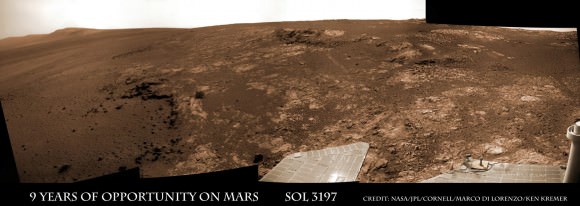
Cape York is a hilly segment of the rim of Endeavour crater which spans 14 miles (22 km) across – where the robot arrived in mid-2011 and will spend her remaining life.
Opportunity has now set sail for her next crater rim destination named “Solander Point”, an area about 1.4 miles (2.2 kilometers) away – due south from “Cape York.”
“Our next destination will be Solander Point,” Squyres told Universe Today.
Along the way, Opportunity will soon cross “Botany Bay” and “Sutherland Point”, last seen when Opportunity first arrived at Cape York.
Eventually she will continue further south to a rim segment named ‘Cape Tribulation’ which holds huge caches of clay minerals.
The rover must arrive at “Solander Point” before the onset of her 6th Martian winter so that she can be advantageously tilted along north facing slopes to soak up the maximum amount of sun by her power generating solar wings. She might pull up around August.
On the other side of Mars, Opportunity’s new sister rover Curiosity also recently discovered clay minerals on the floor of her landing site inside Gale Crater.
Curiosity found the clay minerals – and a habitat that could support life – after analyzing powdery drill tailings from the Yellowknife Bay basin worksite with her on board state-of-the-art chemistry labs.
Just a week ago on May 15 (Sol 3309), Opportunity broke through the 40 year old American distance driving record set back in December 1972 by Apollo 17 astronauts Eugene Cernan and Harrison Schmitt.
But she is not sitting still resting on her laurels!
This past week the robots handlers’ back on Earth put the pedal to the metal and pushed her forward another quarter mile during 5 additional drives over 7 Sols, or Martian days. Thus her total odometry since landing on 24 January 2004 now stands at 22.45 miles (36.14 kilometers).
Opportunity will blast through the world record milestone of 23 miles (37 kilometers) held by the Lunokhod 2 lunar rover (from the Soviet Union), somewhere along the path to “Solander Point” in the coming months.
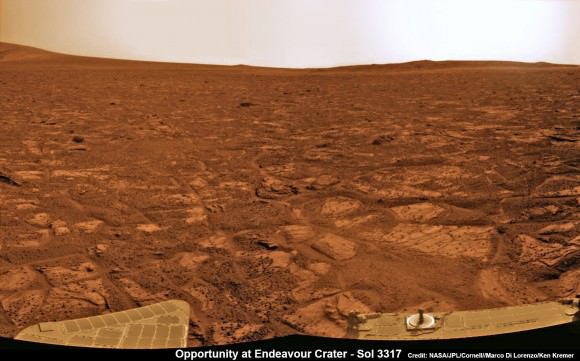
Endeavour Crater features terrain with older rocks than previously inspected and unlike anything studied before by Opportunity. It’s a place no one ever dared dream of reaching prior to Opportunity’s launch in the summer of 2003 and landing on the Meridiani Planum region in 2004.
Signatures of clay minerals, or phyllosilicates, were detected at several spots at Endeavour’s western rim by observations from the Compact Reconnaissance Imaging Spectrometer for Mars (CRISM) aboard NASA’s Mars Reconnaissance Orbiter (MRO).
“The motherlode of clay minerals is on Cape Tribulation. The exposure extends all the way to the top, mainly on the inboard side,” says Ray Arvidson, the rover’s deputy principal investigator at Washington University in St. Louis.
Stay tuned for the continuing breathtaking adventures of NASA’s sister rovers Opportunity and Curiosity!
And don’t forget to “Send Your Name to Mars” aboard NASA’s MAVEN orbiter- details here. Deadline: July 1, 2013
…………….
Learn more about Mars, Curiosity, Opportunity, MAVEN, LADEE and NASA missions at Ken’s upcoming lecture presentations:
June 4: “Send your Name to Mars” and “CIBER Astro Sat, LADEE Lunar & Antares Rocket Launches from Virginia”; Rodeway Inn, Chincoteague, VA, 8:30 PM
June 11: “Send your Name to Mars” and “LADEE Lunar & Antares Rocket Launches from Virginia”; NJ State Museum Planetarium and Amateur Astronomers Association of Princeton (AAAP), Trenton, NJ, 8 PM.
June 12: “Send your Name to Mars” and “LADEE Lunar & Antares Rocket Launches from Virginia”; Franklin Institute and Rittenhouse Astronomical Society, Philadelphia, PA, 8 PM.
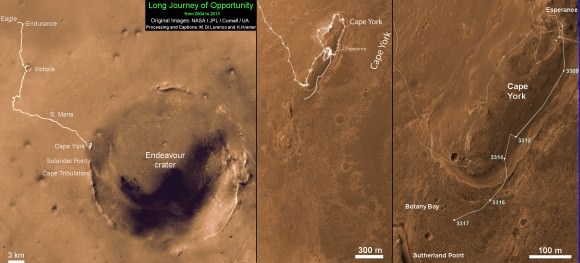
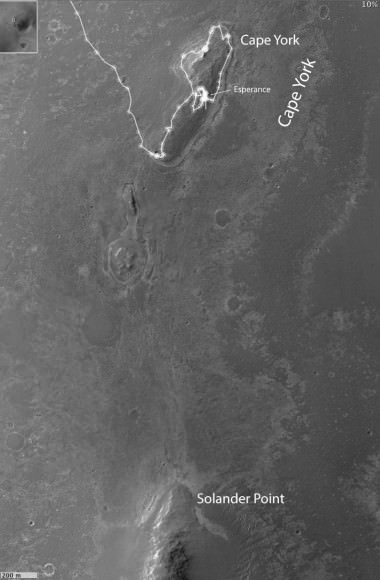
-This map of a portion of the western rim of Endeavour Crater on Mars shows the area where NASA’s Mars Exploration Rover Opportunity worked for 20 months, “Cape York,” in relation to the area where the rover team plans for Opportunity to spend its sixth Martian winter, “Solander Point.” Credit: NASA/JPL-Caltech/Univ. of Arizona

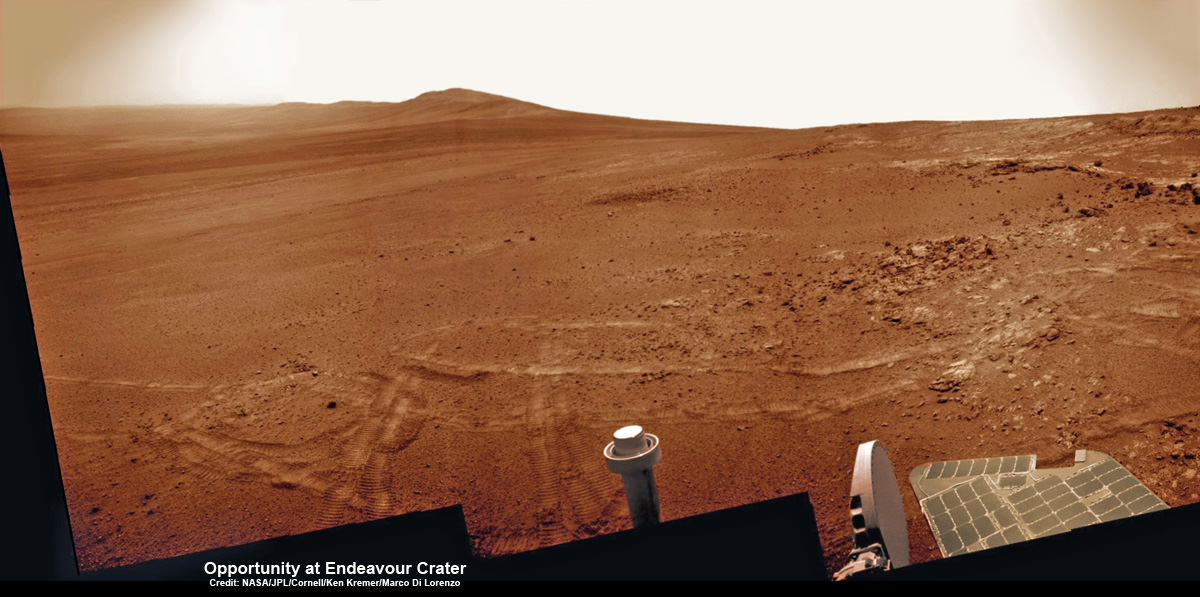
YO! You GO OPPORTUNITY! Get on down with your long lived sojourning self! Every inch has been part of an incredible journey… and now part of my life… I LIKE!
Indeed. Live Long and Prosper !!
Well said Ken: Short, simple, and all Spock. There will be nothing close to the very 1st series of Star-Trek. Gene Roddenberry. The master mind. He induced, implemented, and combined many life lessons with moral values in certain situations. He was brilliant. Mr. Roddenberry shaped minds and aspects of some of us baby boomers perceptions. Even scientists like yourself. Spock is planted and etched into your creative mind. Excuse me, it is Mr. Spock to us…. :-).
8 year olds hearing about opportunity don’t know better than that “thing” has been driving on Mars their whole lifes. I tried picturing something of a likewise experience, and I have to say, its the new things that awe.
But that something with the power of about an electric razor is doing basic science observations and still going on without maintenance and is heading towards a full marathon … Who ever crafted opportunity may love himself for his job well done.
well said – in all respects !!
You’ve got that right. For something that would hopefully run for 6 months, it has been a wonderful exploration device.
Stay tuned for the continuing breathtaking adventures of NASA’s sister rovers Opportunity and Curiosity!
spybubble francais
Thanks for covering the grounds of what Opportunity has covered! It’s starting to sum up to a lot to keep on top of.
Speaking of which, I don’t know how to compare Opportunity’s habitability finds with Curiosity re “the strongest evidence to date for [ancient habitability]”. It is important to see long time neutral water alteration, but Curiosity found that today’s redox states are heterogenous and hence should admit viable neutral patches even today as I understand it.
Without better understanding of the science, which isn’t forthcoming yet, I would see these results as complementary. Opportunity adds to resolving a better view of past habitability, Curiosity adds to resolving a better view of overall habitability.
The upshot of the article, in my mind, is that both rovers have ahead the best yet science targets! Let us hope we will have the opportunity to satisfy our curiosity in the coming years.
absolutely – the best is yet to come! luv that last line
Thank you!
I just love this Rover. what a workhorse.
NASA & ESA and the etc’s have been looking for.Microbial life. Just about every human being on earth knows it is out there on planets. Evidence is their conquest.
Well, we never know how science cross-correlates, but knowing more astrobiology would help knowing Earth biology better and vice versa.
Else research into aging makes strides on its own. Last I heard, but it would need confirmation as per usual, is a result that neurons can live to double the current average lifetime of bodies (in mice). I don’t know how good that science is. And as neurons don’t renew as much the cancer problems with extended life lengths aren’t too bad, so however they do it that is only half the answer.*
This is the generic problem if any technique adds more than a few decades. Whales can live long and beat cancers, birds can live energetically and beat oxidative damage, and the basic construction of cells point to lifetimes of millenniums. (Using death rates from 20 year old’s, before extraneous aging sets in.) Similarly bacteria can divide for ~ 200 generations before their oldest “cap” half, which gets all the accumulated cellular damage, dies.
More longlived complex organisms use a shell principle. Plants grow around cancerous growths, and “colonial” type animals body plans grow new layers and abandon old. We can’t do any of that because of our central neural system (CNS).
But if we beat cancers and fix totipotent stem cells, we could potentially live for tens or hundreds of millenniums as CNS life forms with totipotent stem cell regeneration. To go further we would need genetic therapy to fix any and all possible problems, which seems unrealistic.
OTOH, we have yet to see one day added due to results from ageing research…
*The ethics of making other somatic cells as long lived, if possible, while not cracking the cancer problem is iffy. But I’m sure we would see early attempts where they pawn off cancers to “future research”.
Well, just like in your last reply email to me. You obviously cannot tell the difference between someone kidding or being serious or even just kicking the can around like I was. I was being lofty. Playful. Dreaming of extending my life (everyone’s) so I(we)can experience mankind land human beings on Mars and especially the vast beyond.
I WAS being playful. Wishing for a dream to extend life. Everyone wants to live 1,000 years or even forever! Call it a dream. A wish. I do appreciate your bio lesson. It was honestly Interesting to me. I am a older man in life. Being into my 6th decade of life does not give me too much more time left to see the progress of near or deep space flights ahead of mankind.
I have seen Sputnik cause my USA to freak out and take over the space race. I saw the first moon landing in July 1969 from Viet Nam/South Korea of all places. I want to see mankind discover WARP DRIVE and to go Alpha Centauri and Orion….NOW!…lol….and I want to go too!…lol.
So Mr Larsson (from the Netherlands I believe) I do like your style. I am not a scientists in the sense of the word. I am considered a novice. But I so want to see the year 2413. Get it now?
Right back at ya’. I couldn’t care less for the topic, since the research hasn’t resulted in anything yet.
Of course, you have to read all the way to that last line…
Curious, what email? You must be thinking of someone else.
Yes my bad. I apologize. I did it again. What I did was I read yours and then started another reading another. I stopped half way through yours and started reading another. I assumed I was explaining to the other and started typing to you and combind the two. My bad. That is my 2nd time. You’d figure I learn by now…lol. To ass – u – me…I am the ‘ass’ – not ‘u’ – but ‘me’.
everyday we discover more. Hopefully we will live on Mars in the near future
What can I say?
Hell yeah!
On you’re inspiration, I went to the MSL raw images and took a look thru the recent MastCam images. There was one image taken on Sol 283 where the background scattered rock almost looks like a flat sided salamanderish centipede like critter. Of course it isn’t a critter, instead simple pareidolia? But it got me thinking… Is it possible we may have driven by or taken images of Martian fossils and not known? ~@; )
If your interest in the MSL imagery of Yellowknife Bay take a look here:
http://gigapan.com/gigapans/126968
or full collection of stitched MastcamR MSL observations so far: http://gigapan.com/users/MPJ/gigapans
Viewers were already busy snapshotting interesting bits and pieces so regarding your question: I would say there are a lot of candidate fossil like shapes in all those images (MERs and MSL alike over the years that is).
I was saying to people 5 or 6 years ago that these rovers (opportunity and Spirit) represent one of the greatest human achievements in all our history and the teams that guide and work with these rovers should be given standing ovations. I stand in awe of these men and women and the designers and builders of the amazing little robots that could. And yet, so many people go about there lives ignorant to this wonder. These people and robots are hero’s of humanity and history will always remember them as pioneers and trail blazers. Three cheers to them all!